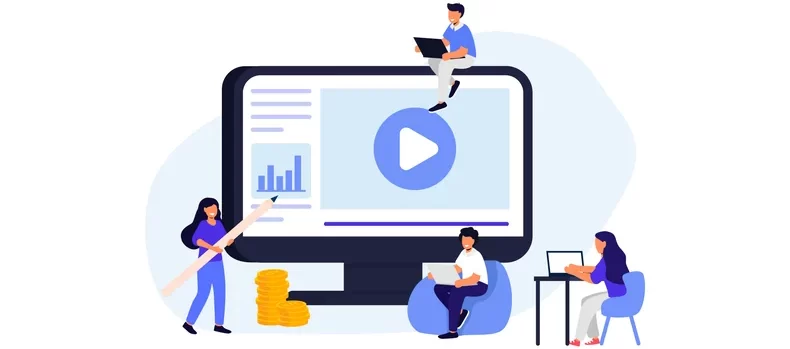Webinars have long had a role in online education and communication, but they became especially popular during the COVID-19 pandemic when it was not possible to have in-person lectures, seminars, and training sessions.
Companies of all shapes and sizes use webinars to connect with their remote audiences for educational, marketing, and discussion purposes, but the popularity of the format also means that webinars can function as a money-making tool. After all, webinars are ripe for monetization.
With a solid grasp of your target audience, a robust webinar marketing and monetization strategy, and the right digital products by your side, you can build a lucrative income with your own webinar.
Curious about what it takes to make a successful webinar and begin making money? Then this article is for you. Below, we’ll guide you through everything you need to know about webinars, including the benefits and a step-by-step guide for how to begin selling webinars on your own website in 2023.

Why should you sell webinars on your website in 2023?
Before we get into the ins and outs of how and why you should put together your first webinar, let’s outline what a webinar is. A webinar is an online video presentation that’s used for the purposes of marketing, education, business, or discussion. Webinar content can take many forms – it could be a Q&A session, a product tutorial, or a seminar – and is often shared live, but it can also be recorded and viewed later as on-demand content.
Benefits of webinars
Hosting and selling webinars on your website can bring a range of benefits:
Wider reach than traditional seminars
You can host a seminar in the real world, but the audience will be limited. There are only so many people physically located in your catchment area, and a seminar room can only be so big.
Online webinars allow you to reach audiences that would otherwise be beyond your reach since there are no geographical restrictions. If the person has an internet connection, they can view your online course, presentation, or sales pitch.
Webinars also get around the problem of scheduling constraints. If an interested party can not attend your live webinar, they can simply view the recorded session at a time that suits them.
Low cost
Webinars offer a more cost-effective alternative to in-person seminars. And that’s true for both the host of the webinar and the attendees. To host a successful webinar, all you really need is a laptop, a webcam, a good internet connection, and a suitable online video platform to host the video.
There are no travel or venue hire costs since you can host the webinar from the comfort of your own home. It’s cheaper for the audience, too, who can watch your content remotely without the need to worry about travel costs.
Lead generation
Both paid and free webinars can be highly effective lead-generation tools and play an integral role in your sales funnel. You’ll likely gather contact information (such as email address or phone number) on the registration page to view your webinar, which you can then use to curate a list of qualified leads when you’re launching new products and services.
Create evergreen content
A real-world seminar exists for the duration of the talk. A webinar can have an impact that lasts for years. Offering your content via video streaming allows you not only to reach and interact with your audience live but also to record your seminar and reuse that content at a later date.
Once the webinar is over, you can upload the video to your website as a VOD (video-on-demand) file, allowing people who could not attend the live stream to access the content.
If you’re using your webinar content for training or educational purposes, recording your content in this way allows you to reuse the same content year-on-year, saving you a significant amount of time and money.
Popular use cases for webinars
Having now seen just some of the benefits of webinars, you may be thinking, “Is a webinar a good fit for my website content?” The good news is that webinars can be deployed effectively for a whole range of different purposes. Let’s take a look at a few examples of the most common use cases of webinar content.
Education
Universities have been shifting towards bringing an increasing percentage of their classes online since the height of the COVID-19 pandemic in 2020. Using webinars as an online teaching tool brings a host of benefits, including enhancing student participation, since they’re a great forum for class discussions and also allow students who cannot attend a class in-person to participate.
Another big advantage of webinars for educational purposes is that they are more accessible for students who can’t attend classes live. Many course creators will record their webinars and make them available to view online after the class is over, enabling students with busy schedules, or those who work in a different time zone than the course provider, to access course content at a time that suits them.
Staff training
With more and more employees working remotely, webinars provide a convenient training platform for employees regardless of their geographical location. In addition, webinars help to reduce the cost of training overheads, such as accommodation, travel, and space hire.
A recorded training webinar will become a long-term asset to the company, which will no longer need to run the same training courses again and again since all the content will be available in an easily accessible video.
Product launches
Webinars also function as useful marketing tools during the product launch process. The interactive nature of webinars allows businesses to answer questions about their new products and get real-time feedback from their customers, enabling them to make adjustments before launching the final product.
Using live events to showcase a new product also offers businesses an effective lead generation tool, providing an email list of potential customers that the business can use in their marketing campaigns once the product (and future products) are made available.
Discussion groups and Q&As at conferences and events
Webinars provide an effective way to enhance interactivity in your online or hybrid events and conferences. With the right webinar platform, you can build rapport with your remote attendees, get feedback, and discover the common questions or issues that your customers experience, which you can then use to improve your products or services, or better target your marketing efforts.
How to sell webinars on your website in 2023
Now that we’ve considered some of the main benefits of selling webinars on your website and taken a look at a few different use cases to inspire you, let’s dive into the steps you’ll need to take in order to start creating and selling your own webinars.
Identify your audience
In order for your webinars to be successful, you’ll first need to attract an audience. But of course, your webinar won’t be of interest to everybody. There’ll be a set target audience that will be interested in attending your webinar, and identifying that audience will be crucial to your success in monetizing your webinar content.
So, the first step in selling webinar content on your website is to understand who your target audience is. This information will be vital right from the offset as it will help to inform the sort of webinar content that you create. Once you know which group of people you’re hoping to attract, you can get to work on producing engaging and relevant content that your specific audience will like.
Understanding your audience is also key to effective marketing. After all, different audiences look for different things and use different platforms. Once you know your target audience, you can find effective ways to market and share your content. For example, business webinars might be best advertised on LinkedIn, whereas Instagram or TikTok might be a better platform for sharing details of your health and fitness classes.
So how can you learn who your target audience is? It all comes down to your market research, which, if done thoroughly, should reveal your “ideal customer,” your competitors and the strategies they use, how much you should charge for your webinar, and your marketing strategy.
Choose a platform
A successful webinar depends partly on the content, partly on the marketing, and partly on the platform that you use. Many people focus on the first two aspects, but overlook the platform element, and end up inadvertently making their goals more difficult to achieve.
Choosing the right platform is crucial for selling your webinar on your website, so how should you select the correct one? Keep the following considerations in mind when making your decision.
Flexibility
In order to get the most out of your webinars, you’ll need to be in full control of their content, look, and feel. Avoid platforms that restrict the type of content you can publish or only offer limited customization options.
The platform you select should work intuitively with your equipment setup and give you the freedom to control the look, feel, and content of your webinars.
Interactivity
The interactive element of webinars is often an important part of their success. You’ll find that you and your viewers get more value from your webinars if there’s a high level of interactivity.
Offering elements like live chat, virtual whiteboards, and screen sharing can add value to your webinars and increase engagement from your attendees, so you’ll want to look out for webinar platforms that support these kinds of supplementary features.
Monetization options
There are a number of monetization options available to people who want to make money from their webinars, which we’ll cover in more detail later in this article. The platform you select should support a range of strategies, so you can utilize the one that’s right for you and make adjustments when necessary.
Meets your audience requirements
You’ll have your own audience goals and targets depending on the type of webinars you want to host. Before deciding on a platform, be sure to have confidence that it can support the level of audience you’re hoping to attract, at a price that you can afford.
Integrates with your CMS
One important consideration when choosing a webinar platform is to ensure that it works with your chosen content management system (CMS). If your plan is to sell webinars on your own website, then we recommend that you choose WordPress as your CMS.
WordPress has built an exceptional reputation for ease of use and is far and away the most popular CMS option because of the many benefits that the platform offers. Here are just a few reasons to use WordPress:
- It’s open source and virtually infinitely extensible.
- It offers convenient sales options via integration with WooCommerce.
- It supports high levels of customization regardless of your experience level.
If you’re looking for the best platforms for hosting webinars on your WordPress website, then we recommend that you start by checking out our in-depth guide.
That said, if you’re looking for a flexible webinar platform that offers all of the above benefits and integrates seamlessly with WordPress, then check out WpStream, which is an excellent choice for selling both live and pre-recorded webinars.

Here are just some of the features that make WpStream one of the best options for hosting webinar content on your own website:
- It offers complete control over webinar appearance and content, with no restrictive content guidelines or third-party branding to distract from your intended message.
- It supports a range of flexible monetization options via WooCommerce integration, including pay-per-view webinars, subscriptions, and donations.
- It is easily extensible, both via WordPress integrations and straightforward connections with some of the most popular streaming software solutions via RTMP.
- It offers a range of flexible pricing plans to suit your audience size, streaming data, and recorded storage requirements.
If you want to check out whether or not WpStream is a good fit for your webinar creation and selling needs, the plugin offers a free trial to give you an opportunity to test out all of its easy-to-use features. You can sign up from the WpStream homepage.
Decide on your monetization strategy
And now to the fun part: how to make money from your webinars. There are various monetization strategies that you can utilize, and we’ll run through some of the most popular options below.
Pay-per-view webinars
Similar to buying a ticket to an event, pay-per-view webinars charge a one-time fee to attendees to access your webinar content. This strategy is particularly popular with those who host one-off webinars (for example, Q&A sessions or discussion groups at conferences or other events), and is suitable for both live and recorded webinars.
Subscription-based webinars
This model involves charging a recurring fee to subscribers, who can then access a series of webinars. It is suitable for online courses and often uses pre-recorded content, which course creators can make accessible all at once or drip-feed to users gradually in order to increase retention and boost subscription revenue.
Free webinars
Giving your webinars away for free may not sound like a great monetization strategy, but they can and do work. Think of them as an investment in your lead generation strategy. If a person is interested in your webinar content, they’re likely a qualified lead that may be interested in purchasing your products or services now or further down the line.
Market your webinar content
Selling your webinar content directly from your website will only be successful if you have an effective marketing strategy that helps to attract attendees.
Selecting the right strategy will depend on both the type of webinars you’re selling and your target audience. This is where the market research you conducted at the beginning of the webinar development process comes into play. You can’t create an effective marketing campaign without understanding who you’re marketing to.
Social media provides an excellent platform to market your webinars, but it’s crucial to select the right social media site. Essentially, it’s all about choosing the site where your target audience spends the most time; for example, TikTok for a younger, “Gen Z” audience, or LinkedIn for a more professional audience.
Aside from social media marketing, there are several other marketing strategies that you’ll want to consider in order to increase attendance numbers and engagement with your webinar content:
Affiliate marketing
Affiliate marketing enables you to tap into another website’s audience by creating an affiliate partnership with the website owner. The website owner – your affiliate – will promote your webinar content on their own media platforms in order to increase sign-ups or sales. In return, you pay the affiliate a flat fee or commission for each sale made.
In this way, affiliate marketing helps you to reach a wider audience with your webinar content without the need for up-front investment. While paying a commission for any affiliate sales of your webinar content will reduce your profit margins, this is often worth it to help increase exposure for your content and generate leads that you can nurture into further sales down the line.
Email marketing campaigns
Have an email marketing list? Then put together an email marketing campaign advertising your latest webinar content. If you don’t have an existing email list that you can leverage, offering free webinars can be an effective lead magnet that you can use to curate a list of qualified leads and sell future pay-per-view or subscription content.
Content marketing
One effective way to attract interest in your webinars is by publishing search-engine-optimized (SEO) content, including videos, blogs, and social media posts related to your webinar subject. By creating content that ranks well in search engine results and using a strong call to action (CTA), you can increase the visibility of your webinar content and increase sign-ups.
Take the first steps to start selling webinars on your website
The many benefits of selling webinars on your website are hard to ignore. From their wide reach to their low cost and potential for lead generation, there’s no surprise that webinars are growing in popularity among content creators.
To find success with your webinar, it’s important to have an understanding of your target audience and develop robust marketing and monetization strategies. And, above all, you’ll need a quality platform to host your webinar content.
If you’re looking for an easy-to-use and effective webinar platform, then check out WpStream, which offers full control over your webinar content, extensive flexibility, and a range of options for monetization and interactivity.
To get started, check out WpStream’s pricing calculator to see the flexible pricing plans available to you, or test the plugin out with a free trial.
Table of Content







